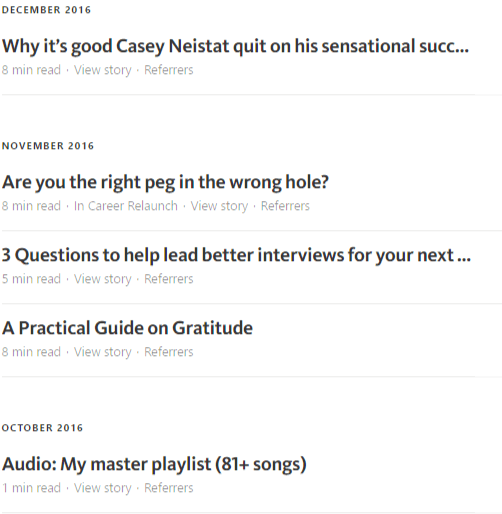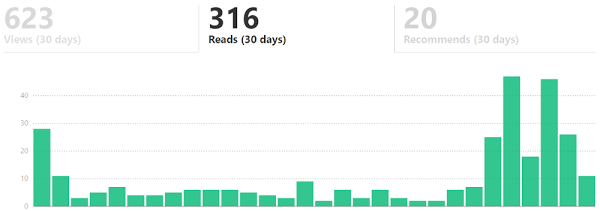Becoming a freelance writer on the side of your day job can be one of the best ways to augment your income & work towards being your own boss.
Landing your first freelance writing client is a major milestone on that path.
Something to be extremely proud of. To get excited about. To celebrate.
The affirmation that you can actually get paid to do something you love—write. The incredible feeling that you could now be on the path to eventually becoming a full-time freelancer.
I can vividly remember the very first time I was paid to write a blog post as a freelancer (while still working a full-time gig).
It was exhilarating. Mostly because of the amazing possibilities this first freelance writing client represented to me and the business I envisioned for my future.
After nearly a year of being a freelance writer full-time, I’ve been able to build a sustainable freelance business for myself.
To be clear, it’s been a lot of work. But, I’ve been fortunate enough to work as a freelance writer for both startups and brands like LinkedIn, Zendesk, Intuit, Adobe, Vistaprint and more.
Here’s the exact process I used to become a freelance writer—and how you can make progress today towards landing your first freelance writing client too.
As with anything in the world of freelance writing, there are as many ways to “make it” as there are successful freelancers.
The other day, I was reminiscing with a friend and fellow freelance writer, Bogdan Zlatkov who teaches at GrowthHackYourCareer, about the indescribable feeling that first milestone (getting your first paid freelance client) can create. And that got him thinking more about how he landed his first freelance writing client.
Bogdan and I are both freelance writers & content marketers here in San Francisco, which is a pretty close community. We’ve collaborated together on a few projects and always share freelance-related resources with each other.
But, it takes a lot to become a freelance writer and sustain yourself financially—especially somewhere with such a high cost of living.
And we both know just how many people from around the world want to start freelance writing careers.
That’s why today, Bogdan is sharing his story with us and the lessons he’s learned along the way—when it comes to becoming a freelance writer and landing your first freelance writing client.
Here’s Bogdan, in front of (and behind) the camera:
Check out more of Bogdan’s work over on his Medium page.
And grab my free templates if you need a solid freelance contract or freelance proposal to get your business off the ground.
I’ll let him take it from here…
Here’s Bogdan:
For me, becoming a freelance writer started from a place of frustration and self-doubt.
At the age of 26 I had hit my first quarter-life crisis.
I was asking all sorts of tail-chasing questions like, “Is this all there is? Is this real happiness or just a facade?”
All very productive as I’m sure you can imagine. But to put it briefly, I wasn’t happy.
What confused me at the time was that all outside indicators said that I should have been beyond happy.
After all, I was living the dream.
I was being paid (generously) to travel the world and go on adventures.
My day job as a travel videographer meant I was getting paid to fly to different cities, do everything awesome in that city (including zip-lining, horseback riding, snowmobiling, skiing, wine tasting and eating at Michelin star restaurants), then film it for my clients.
The dream job in a nutshell.
So you can imagine my surprise when, as I sat at my desk looking at the empty editing screen wondering which video clips to drop in, I couldn’t help but notice a deep sadness enveloping me.
Even though I had achieved my dream scenario, to travel, to film, to get paid, I was still unhappy.
Was I being greedy? Was I simply ungrateful? The problem was that I felt as though I was living my life on repeat.
Prep, shoot, edit.
Prep, shoot, edit.
At the time I didn’t know how to break the cycle, all I knew was that something needed to change.
After months of indecision and frustration, I finally decided not only to change jobs, but to change careers entirely.
I decided to start from scratch, to begin at the bottom, and to climb the career mountain once again.
I decided to become a freelance writer and enter the world of freelancing.
Getting Your First Freelance Writing Client.
If you’re reading this, chances are that your dream scenario is to get paid to write.
Maybe you envision yourself sitting on a beach with a laptop drafting your latest masterpiece.
Or maybe you envision yourself in a busy high-rise cranking out the latest headline worthy story.
Either way, you’re not there yet, you’re here. But that’s ok.
A lot of people want to learn a “hack” about how to instantly achieve incredible success with their goals. They think that if they only knew that one trick, they’d be propelled forward into stardom and riches.
And while sometimes this kind of transformation is possible, as is more common with anything in life, there’s a lot of things that need to happen before that magical “aha!” moment comes along.
When it comes to freelance writing, there are three critical steps you need to take before you even begin to pursue clients.
Getting your first freelance client actually depends largely upon learning how to leverage metrics and then presenting those metrics to your potential client.
But even before you learn that, of course it’s all about…
1. Building a Writing Habit.
Here’s a quote I live by.
“Most people think they can wait around for the big moments to turn it on, but if you don’t cultivate turning it on as a way of life in the little moments, and there are hundreds of more little moments than big, then you have no chance in the big moments.” — Joshua Waitzkin
Joshua Waitzkin might be one of my favorite people on the planet.
He is a chess grandmaster, he was the basis for the film Searching for Bobby Fischer, he’s a Jiu Jitsu blackbelt and a Tai Chi push hands world champion. He’s essentially the master of mastery.
[Note from Ryan: One of our favorite writers, Tim Ferriss, has interviewed Josh multiple times on his podcast and published all of Josh’s best excerpts & lessons in a massive section of his latest book, Tools of Titans.]
Now that Josh has retired from all of the above, he teaches top performers how to master any given subject.
The biggest key lesson that he always begins with is the habit of practice.
There isn’t a single top performer in the world who has not practiced their craft. Coincidence? Definitely not.
One of the key mistakes I made when I was first trying to switch careers was to think that because I was smart, studied creative writing and had a strong work ethic, I could just turn on my writing muscles when the time came.
Josh explains that this is the biggest misconception he sees in the people he coaches.
He explains that rather than seeking to improve ourselves through small moments, we seek out one big moment to make everything happen.
And yes, while getting your first freelance writing client will be a big moment, you cannot reach that moment without growing your writing muscle in the little moments.
This is why I decided it was imperative to have a regular writing practice, in order to become a writer.
I realized that starting a blog of my own was probably going to be a daunting task.
Not so much because I couldn’t build a website, but because it would take me ages to build an audience. I wanted to be a writer, not a marketer.
So I decided to start simple and posted my first article on Medium. I think it’s an okay article but definitely not anything worth being published in Forbes or Entrepreneur.
Most people think that writing is pointless unless there is someone who reads their stuff, and so they never start in the first place.
Starting a writing practice is kind of like learning to play the trumpet.
At first no one will want to listen to you because, to put it gently, you suck.
With any instrument you need to get at least a year of practice under your belt before you’re worthy of even the smallest audience.
The good news is, if you start writing today, you’re one less day away from reaching your goal.
As you start building your writing practice, here are a few things to keep in mind:
1. Publish your first post immediately.
Set a realistic expectation for your first post. Don’t try to write something profound, just write what makes you happy. Then, hit publish. It doesn’t have to be perfect (hint: it won’t be). After all, not many people are going to read your first post, so just get it out there in the public.
2. Start slow but not too slow.
In my first month writing, I published only one article. In my second money, I wrote two articles. In months 3–12, I wrote on average 2–3 articles. The important thing here is to improve your practice, not perfect it.
3. Grow your following as you grow your skills.
The single best thing you can receive as a first-time freelance writer is one fan. Distribute your writing in the easiest way possible until you get that one fan. I like to put my articles up on Medium, Reddit, and Quora where people can upvote and comment on them so I can get feedback.
4. Don’t lock yourself into one topic.
When I was first starting out I had no idea what my niche was. It took over a year to start narrowing down what I write about and I mostly figured that out by putting content into the world and seeing what sticks. Keep an open mind and write about what you like at first.
5. Delete and draft without mercy.
About 25% of everything I’ve written sits in my drafts folder and never gets published. That doesn’t mean that I shouldn’t have written these pieces in the first place. The bad stuff is typically the only way to reach the good stuff. It’s important to write consistently and not be afraid to fail.
If you hate your writing, don’t publish it. But write it nonetheless.
The first steps to becoming a freelance writer are an incredibly fragile time.
You’re trying to do something brand new and while that’s exciting it’s also fairly terrifying.
It’s hard to recommend how much writing you should be doing because everyone has their own output constraints.
In general though, I’d say you can always do more than you think you can. The important thing is to have consistency.
[Note from Ryan: Personally, I’ve found that creating the time for myself to just sit down and write at least once per week for 3-4 hours without expectation has been incredibly helpful for staying sharp, exploring new thoughts and improving as a writer.]
I’ve found that a good way to hold yourself accountable is by using the Stats feature on Medium.
It breaks down all your posts by month so you can keep yourself honest about the consistency of your output.
As you can see, some months have more posts than others, but the important thing is that it averages out to about 2 posts per month. There’s an important balance you need to strike between taking it easy on yourself and pushing yourself.
You don’t want to give up too soon which is what will happen if you overwhelm yourself.
Each person has their unique balance, so take the time to find yours.
2. Take a Data-Driven Approach.
Over the course of my year seeking a new job, I did over 67 interviews with 22+ companies.
It was depressing to say the least. I spent hundreds of hours prepping and selling myself in a field I barely knew.
Luckily, I recorded it all and turned it into a blog post. To this day it’s still my #1 most read blog post.
(Pro tip: Usually your most difficult or painful moments make for the best writing.)
As I went from interview to interview, one common trend I found amongst all companies was that they cared a lot about evidence.
During each interview I would ask them why they were looking for a new content writer and the answer I received most commonly was, “our previous writer was a good writer but she just wrote on topics randomly and didn’t measure her work in any way so it didn’t work out.”
Measure your work.
This is incredibly important. It may seem that creative pursuits are free from the confines of science and math but this simply isn’t the case anymore. Even art museums measure their visitor’s every step nowadays.
Go deep with your metrics.
When I used to shoot videos for a living it, we didn’t just measure how many views we got, we measured what sources the views came from, what our demographics were, how long people stayed on the video, and even where they went to after viewing the video.
Everything was measured so that we could improve for the next video.
There are a few key ways to add measurement to your writing.
The first and most obvious one is to see how many views you get.
If you use a platform like Medium, you can also see how many people read your article compared to viewing it. You also have metrics like recommends and comments which you should take fairly seriously.
A few other ways to measure your writing without making a full website is to put tracking links throughout the article. I use tracking links in every article I write, so if you’ve clicked one of the links above or below this I’ll know about it. This gives me insights into what sparked curiosity and what resonated with my audience.
After the actual skill of writing, I found that measurement was the #2 most important skill that separates good writers from great writers.
Ryan is the master of this. If you look at his freelance writing page, you’ll notice that 95% of it is dedicated to showing metrics for why his writing works. This is key for proving to new clients you can do what you say you can do.
If you’d like to see a sample of the Strategy Breakdown I send to my clients, enter your email here and I’ll send you a copy. Feel free to copy it and use it for your own clients!
3. Save Your Research.
Another quick hack I’ve found has been to save all my research in a handy PDF or ongoing Google Doc.
Since I was new to being a freelance writer, I was doing a ton of research on what was effective when it came to creating a content marketing strategy in particular.
I quickly built up a long list of bookmarks with research papers, case studies, and best practices.
Later, when a potential client raised questions about why I made certain decisions, I didn’t have to argue with them because I could point them to a study and they quickly saw my credibility.
Since you’re just starting out you’ll be learning a lot of current best practices. Use this opportunity to not only save that juicy info in your brain, but to also save it for your future employers.
Use those bookmarks and you’ll be glad you did.
4. The Poser Test: Know Your Writing Jargon.
I have a love/hate relationship with writing jargon. In the past I would get so frustrated that in order to have my ideas taken seriously I needed to deliver it with a bunch of industry jargon.
When pitching a new video idea to a client I couldn’t just say, “this video will resonate with people because it’s fun, cool, and entertaining.”
That usually didn’t cut it. But if I explained, “we hope to increase our CTR by creating a lead-gen asset that’s cohesive with your brand. Our CTA will draw people to the LP through a trackable UTM campaign where we can then nurture them through the conversion funnel more effectively.”
If you didn’t understand anything above, don’t worry.
Industry jargon is there to keep the posers out. It’s a test that you need to learn to pass, or you’ll be left scratching your head in a lot of conversations.
Here are a few of the most common industry terms that you should know and use:
CTR: Click-Through-Rate. How many people clicked on your article.
Lead-Gen: Lead Generation. How many emails your article got from readers that the sales team can follow up on.
CTA: Call to Action. A clear instruction, usually at the bottom of your article, of what you want the reader to do next. Examples: sign up for an e-book, read another article, submit their email. Pro tip: Always have a CTA!
Conversion Funnel: This is a metaphorical funnel of taking a customer who knows nothing about you (top of funnel) to buying your service or product (bottom of funnel). This is very important to businesses and definitely something you should talk about in relation to your writing. Read this post about sales funnels for a more comprehensive definition and .
Backlinks: Links that point to your website or article. Getting other websites to point to your article is very important for SEO. You should always try to collaborate with other websites to drive traffic to each other’s sites.
SEO: Search Engine Optimization. This is how well you rank in google. The reason that most companies have a blog is to improve their ranking. You should always talk about how your writing improves SEO and how you pay a lot of attention to SEO optimization.
Keywords: A keyword phrase is 2-3 words that your article focuses on—it’s what you’d ideally want to rank for in Google’s search results. This article, for example, is focused on the keywords, “freelance” “writing” and “client.” You should learn how to do keyword research and try to use your most important keywords as much as possible, while maintaining a natural voice.
LTK: Long Tail Keywords. Long tail keywords are phrases related to your keywords which describe your topic in greater detail. While it may be hard to rank for the word “sofa” it’s far easier to rank for “antique love seat.” You should try to use LTKs to improve your SEO and lower your CPC.
CPC: Cost Per Click. This is how much it costs every time someone clicks on your ad. If you are buying ads for a keyword like “freelance” your cost will be very high because there’s more competition. You should be telling your clients you can lower their CPC.
Editorial Calendar: A calendar used to plan your blog. You should aim to plan at least 3 months in advance if you’re working for a client. Building an editorial calendar is something you should mention you’ve done before.
UTM: A trackable link used for google analytics. This is text you add to the end of your links to track where traffic is coming from for your blog posts. You can also use Bitly to do this easily.
There are certainly more, but these are the bare minimum that you should know to get your foot in the door.
You should definitely be using these tastefully (when necessary) during the pitching process with potential clients, but don’t go overboard.
A little jargon goes a long way to convincing prospects that you’re the real deal. At least now you’ll know what someone means when they say:
“We plan on increasing our CTR and SEO through LTK optimization and backlinks. This should reduce our CPC dramatically while effectively increasing lead-gen and conversions along the funnel using improved CTAs. Of course we’ll measure everything with UTMs and adjust the Editorial Calendar accordingly.”
(Pop tip: Never actually use a sentence like this.)
5. Craft Your Pitch and Identify Your Dream Clients.
Okay so you’ve been hard at work writing blog posts, you have some experience under your belt and you have stats to back it all up.
Now it’s time to get your first paid client.
There are two approaches you can take here and my approach is slightly different from most on this topic.
Finding full-time opportunities and turning them into freelance gigs: When I started this new writing journey I was mostly looking for full-time employment. I spent about 6 hours a day doing my video work and another 3 hours applying for writing & content marketing jobs.
As you can imagine, over an 8 month period I got really good at interviewing. To sum it all up I wrote a huge 4500-word post about how to apply for jobs, so if it’s a full-time job you’re after that’s something worth taking a look at.
As is typical with success stories, it didn’t go exactly as planned. My first freelance client was actually supposed to be my first full-time job, but that didn’t pan out.
As happens often within the startup world, it was simply a lack of money that determined my future.
The company I applied to was nearing profitability (after 5 years of hard work) and they couldn’t justify to their investors adding more costly staff. After going through 2 phone interviews and 3 in-person interviews, including one with the CEO of the company, when I got the email saying they couldn’t hire me, I was devastated.
After bashing my head into the wall a few times (metaphorically of course), I couldn’t accept that I had nothing to show for all this hard work.
Rather than lose 2 months of my time and effort, the solution I came up with was to pitch them on being a freelance writer for them.
I made my case that I could freelance for the company for now until they could afford to bring me on full-time. This actually ended up turning out great because I could have some income flowing in while I looked for additional freelance clients.
Once I saw that this approach worked, I decided I would try it with other companies as well. I would apply to full-time jobs and once I knew they loved me and wanted to hire me, I’d ask them if I could go freelance with them instead. Not everyone said yes, but those that did turned into great relationships.
(Pro tip: A great way to get around “no” is by asking if you can try a trial period: “Why don’t we just try this for 3 months and if it doesn’t work out, we can part ways.”)
Perfecting your proposal and mastering the pitch: Another great way to get clients is by using Ryan’s rock-solid freelance proposal and the outreach system he uses.
His methodology is built around doing everything you can to stand out from the crowd of freelance writers who are pitching your dream client—and rise to the top by providing immense upfront value.
So, instead of just applying for a freelance writing gig through the company’s website or emailing a hiring manager, Ryan’s pitching formula recommends creating high quality content (that your clients could envision paying you for) and publishing it first to your own blog or Medium account.
Then, he recommends mentioning and linking to the clients you want to work with—in the content you’re writing for yourself.
After you publish these portfolio pieces, promote them a bit and show that you can get social shares and drive audience. That then gives you the opportunity to reach out to an individual decision-maker at your target client company to let them know about their feature within your post.
What I love about this approach is that it’s so different than the way most freelance writers are trying to land new clients. It shows that you’re a proactive doer.
Here’s the cold email template Ryan uses to pitch his freelance clients, which is custom-tailored to each client.
Ryan’s Cold Email Template for Pitching Freelance Writing Services:
For this example, the pitch is designed for a finance startup that has a suite of tools for personal finance and a popular blog as well.
Subject: Your feature on my blog
Body:
Hey FirstName,
I’ve been a [Company] user (and reader) for years, and always recommend it to friends that are trying to take their finances seriously.
I wanted to give you a heads up that I featured [Company] as a resource in my post about how I managed to save $500/mo and the post has been getting a great response with my readers. Hoping it’ll send some traffic and new users your way 🙂
Would you mind taking a look at the post when you have a chance to make sure I’m linking to the best destination for you?
Happy to make some edits or link to another article that’d be useful to my readers.
YourName
This email opens the dialogue—and provides value.
At this stage, you’re still not really asking for anything. You just want this person to check out the post you featured them in so they can see the quality of your writing. You’re building the relationship.
[Note from Ryan: Here’s how I like to think about this. Don’t ask your potential client to marry you on the first date. Show them you can be a good partner, then work your way up to a first date ?]
Once they get back to you, then you can transition the conversation over to asking if they’d be up for having you contribute to their blog and test the waters for whether or not they pay their freelance writers.
If you want more on Ryan’s pitching process, download his freelance proposal template and check out his course on winning dream clients.
6. Know the Tools and Set Your Rates.
Here are a few tools that will help you create credibility to your writing.
Coschedule Headline Analyzer.
I use this to check how clickable my headlines are as well as to justify my topics to prospective clients. You can take screenshots of the data the analyzer provides and then use it for your strategy breakdown. If you’d like to receive my sample Strategy Breakdown I send to all my clients, enter your email and I’ll send it to you. I used mostly Coschedule’s headline analyzer to make it, but it always impresses potential clients.
Google’s keyword planner is a great way to judge the demand for your topic. Once you start getting serious about your writing, it’s important to measure how much demand there is for a given topic. In addition to judging demand though, you should also judge competition. Going for a topic such as “how to start freelancing,” will be an SEO struggle, while writing about something niche like, “how to become a freelance gardener for tiny houses,” will probably earn you way more click-throughs.
I use the Alexa chrome extension to see which websites have high authority. This helps when you’re trying to figure out who to reach out to for distribution of your writing. It’s best to reach out to smaller sites at first so that you increase your chances of being published. The biggest tell of how much authority a website has is the number of links pointing to it. Alexa tells you that plus competing websites who you can also reach out to.
I use bitly’s chrome extension to easily create trackable URLs. If you sign up for an account, Bitly will automatically track your links. This is much easier than setting up a full fledged google analytics account. Again, reducing the amount of work you have to do is directly linked to how likely you are to succeed at your career as a freelance writer.
Simple, beautiful, and highly effective. I use the Momentum chrome extension to set reminders to write. Every time I open my browser I get a beautiful photo along with a friendly reminder that I should be writing today.
Setting Your Rates.
[Note from Ryan: Before getting too far into your conversations with potential freelance writing clients, you need to make sure you’re charging enough to earn a living wage.
I created an infographic that walks you step-by-step through that calculation, which you can check out on my blog right here.
TLDR; Back out your current hourly rate from your salary. Calculate your minimum freelance hourly rate by adding at least 25% to the number in order to compensate for additional tax liabilities on that income (self-employment tax) and more upcoming expenses like healthcare, office space, additional online tools, faster internet at home, higher utility costs at home and so on once you’re doing all work from home jobs full-time.]
7. Signing Your First Client (and Throwing a Party ? ).
Regardless of where you are in your writing journey, know that there will be highs and lows.
When you’re first starting out becoming a freelance writer, you may be tempted to work hard, pour your heart and soul into your work and become successful as quickly as possible.
Please don’t do that. It will only burn you out.
There’s an important balance that you need to find for yourself that will keep you going for the long haul.
Despite what the media and magazines may tell you, there is no way to achieve your dreams overnight, in a week, or even in a year.
My success as a freelance writer may seem to have come relatively quickly. In one short year, I went from no clients to being fully employed as a freelance writer.
But let’s take a quick step back and look beyond the headline…
• I spent 2 years in college studying creative writing.
• After college I created a website where I wrote about 20 articles. It never took off but it added to my experience. (Note: this is the first site I ever built. It’s pretty bad, but it gives you an idea of the early days and a willingness to experiment and fail.)
• I wrote on Medium every month for a year.
• I studied content marketing on my own for about 3 hours per week, every week.
If we add all of this experience up, it equals far more than the one year that the outside world sees.
I don’t say this to get you down. Quite the opposite in fact. As you begin your journey as a writer, you’ll be desperate to gain traction.
You’ll say things to yourself like, “No one reads my stuff. Maybe I’m not actually good at this. Maybe this isn’t what I want to do.” You’ll tend to look at your big lack of success rather than your hundreds of little successes. As Joshua Waitzkin says, “there are hundreds of more little moments than big moments.”
Notice them.
Maybe one of your Facebook friends comments on your writing. Good. Maybe someone likes your tweet. Great. Maybe you get your first follower on Medium. Awesome. Maybe someone reaches out to you to thank you for your writing. Even more exhilarating.
The only way to become a freelance writer is to put in the work, over time, and be in it for the long haul.
Yes, you should be gaining traction and improving.
Yes, you should be measuring your traffic and optimizing your keywords.
Yes, you should be creating strategic proposals and reaching out to clients.
But no matter what you do, acknowledge your wins.
That will take your farther than any tactic I’ve outlined above.
If you’d like to reach me, show me your writing, or even get a little advice, I’m always available @BogdanYZ on Twitter.
If you want to read some of my stuff, here are a couple of articles I’m pretty proud of:
And if you want that strategy breakdown to send to clients, you can get it here.
I hope that as with everything I write, that this article has helped you in some way.
Happy writing and good luck!










This is such an awesome post, thank you Bogdan!
Great post! Insightful and informative!
Love this! Definitely sharing 🙂
this is well written and communicated. thank you.
An intricate beginner’s guide. Thank you so much Bogdan
Glad you enjoyed it Binibini!
This paragraph gives clear idea in support of the new visitors of blogging, that actually how to do running a
blog.
Amazing post, it helped a lot!, and also was so enjoyable to read 🙂
This is amazing.. I have been looking such kind of ideas so far.. You have written it so well.
Thank you for the encouraging words. As I read your article about being 26 and having a quarter life crisis I literally laughed out loud. I am 26; I texted my best friend the other day about having a quarter life crisis and wanting to make a career change to focus more on my writing and now today I find your article. I think I have found my beginning.
So glad to hear the post resonated with you! The quarter life crisis is definitely real and I think having a fresh start is incredibly liberating (although tough while you’re going through the transition). Best of luck!
Thank you for this fantastic starting point. You are worth your weight in gold! After years in the corporate world, and some additional ones with my kids, it’s time for a change. I have a love for all writing and it’s time to pursue that passion.
You can’t imagine how much these guidelines mean to me.
Thanks again.
Thank you for the kind words! I’m so glad that this was helpful to you and I hope to see your writing up on Medium soon. Add me on Medium and I’ll add you as well so we can both be accountable 😉
Thanks so much. I’m so lucky I stumbled across this so quickly. This article has helped me clear through a whole lot of clutter.
I’ll follow your tips to the letter. I’ll follow you on Medium, too.
Thanks, again.
I’ve been swirling in a vortex of thoughts and questions about turning my freelance writer identity into one which exists in the real world and not just within my heart and mind! How many compliments must I receive from others before turning my inherent talent into a profession of passion??!! I know it comes down to overcoming fears of change and uncertainty. So thank you very much for your wonderful article ~ which can hopefully help to erode any such fears. It was a delightful and informantional read!
Thanks for the kind words Chrissy! I’m glad that you found it helpful and I hope you’ll continue following that writing bug. Doing freelance writing doesn’t need to be risky, I recommend getting started today and build up your “courage” overtime as you get little wins here and there. It’s definitely a years-long process not just a months-long process.
Keep going you can do it!
Bogdan
my name Mena Hany Wadie from egypt and i have 29 yearsold
kindly i need your help to be a freelance writer and to get the first ckient
thanks in advance
My name is Suliat Adebola from Nigeria. I am 23 years old. I need your help on how to become a freelance writer and how to get my first client. Anticipating your reply. Thanks
Wow. This is excellent. Being a content writer and freelancer. I loved your writing style. You provided much value to your readers. Keep it up 🙂
Woo! All praise goes to Bogdan for this one 💪
This is quite informative, have always wanted to become a writer but find it hard to start. This is so helpful. A million thanks.
💪
Quite helpful, thanks
You’re welcome, Ify!